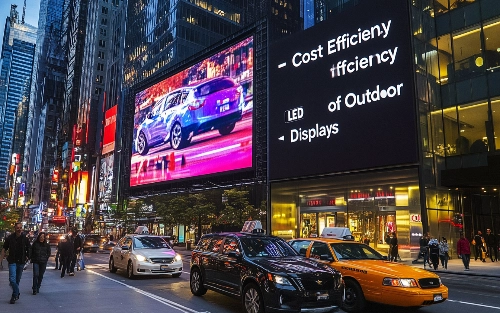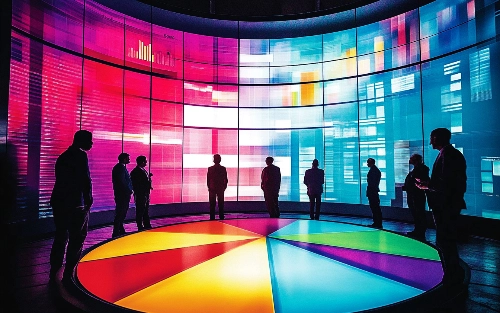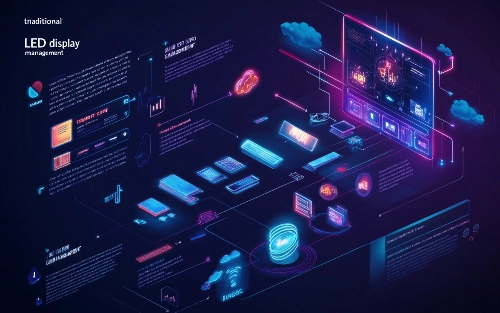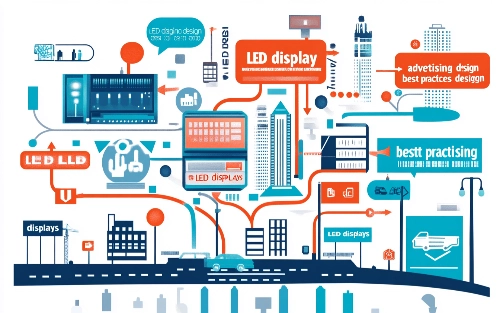As digital transformation continues to influence every aspect of our lives, businesses and institutions are turning to high-tech display solutions to captivate audiences and streamline operations.
View More
Did you know that businesses using outdoor advertising led displays can increase their visibility by up to 47%? That's a game changer. These vibrant, eye-catching displays are transforming the advertising landscape. They grab attention and engage potential customers like never before.
Outdoor advertising led displays offer flexibility and creativity, making it easier for brands to showcase their message in real-time. From dynamic visuals to targeted content, they cater to diverse audiences effectively. This post will dive into the benefits of using these displays and how they can elevate your marketing strategy. Get ready to discover why outdoor advertising led displays are essential for modern businesses.

Outdoor LED displays offer significant cost efficiency in out-of-home advertising. They reduce the need for frequent printing and installation of traditional billboards. Once installed, these digital screens can display multiple advertisements without extra costs. Businesses can save money on materials and labor over time.
Using outdoor LED advertising screens allows companies to adjust their messages quickly. They can change content daily or even hourly. This flexibility means businesses can target specific audiences at different times. For example, a restaurant can promote lunch specials during the day and dinner deals in the evening. This adaptability enhances advertising effectiveness.
FLEXStorm displays showcase remarkable versatility for various uses. These outdoor LED screens fit numerous environments, from sports arenas to shopping centers. They can be used for live events, promotional activities, or information sharing.
Outdoor LED display options include various sizes and resolutions. Businesses can choose screens that best suit their needs. Some may prefer larger displays for high-traffic areas, while others opt for smaller screens in quieter locations. The customization possibilities are endless.
FLEXStorm displays also support various content formats. Businesses can show videos, images, or animations to attract attention. This variety keeps the audience engaged and interested.
Reliability stands out as a key feature of outdoor LED displays. These screens perform well in all weather conditions. Rain, snow, or extreme heat does not affect their functionality. Manufacturers design them with durable materials to withstand harsh elements.
Outdoor LED advertising screen boards often come with protective features like water resistance and UV protection. This durability ensures long-term use without frequent repairs or replacements.
Businesses benefit from this reliability by maintaining a consistent presence in the market. Customers see ads regardless of the weather, enhancing brand visibility.

Digital out-of-home (DOOH) advertisements have a high recall rate. Studies show that 47% of viewers remember the content they see on digital displays. This is significantly higher than traditional advertising methods. The dynamic nature of LED displays captures attention effectively. Moving images and bright colors stand out in busy environments.
People often encounter these ads while commuting or walking. Their attention is drawn to the flashing lights and vibrant visuals. This immediate engagement leads to better retention of the message. Research indicates that the combination of motion and brightness increases memory recall. Brands benefit from this by ensuring their messages stick in the minds of potential customers.
Engaging visuals play a crucial role in attracting more attention from passersby. Bright colors and animations make ads more appealing. People are naturally drawn to movement. A static billboard cannot compete with the lively display of an LED screen. For instance, a restaurant may showcase its signature dish through an enticing video. This attracts hungry customers who might not have considered dining there.
The placement of these displays also matters. Locations with high foot traffic, like shopping districts, maximize exposure. Eye-catching content can create buzz around a brand. Social media interactions often follow when people share what they see. Engaging visuals turn passive viewers into active participants in brand promotion.
Memorable content enhances brand recognition significantly. Ads that tell a story or evoke emotions leave lasting impressions. For example, a campaign focused on community involvement resonates well with local audiences. Such connections foster loyalty among consumers.
Brands should focus on creating unique experiences through their content. Utilizing humor or relatable situations can make ads unforgettable. When people remember an ad, they are more likely to seek out the product later.
Incorporating interactive elements can further boost engagement levels. Touchscreens or QR codes encourage viewers to interact directly with the advertisement. This interaction not only captivates but also provides valuable data for brands.
Clear messaging is essential as well. Simple, concise slogans are easier to remember than complex ideas. Brands must ensure that their core message comes across quickly.

Different advertising needs require various solutions. LED video displays offer customizable options to fit any campaign. Brands can choose from different sizes, resolutions, and brightness levels. This flexibility allows for effective messaging in diverse environments. For example, a retail store might opt for smaller indoor LED screens to showcase promotions. In contrast, a large outdoor display may be needed for a sports event.
Advertisers can also select the pixel pitch of their screens. A smaller pixel pitch provides higher resolution images, ideal for close viewing. Larger pitches work well for long-distance visibility. This adaptability ensures that each display meets specific marketing goals.
Weatherproof technology plays a crucial role in outdoor advertising. SMD (Surface-Mount Device) and DIP (Dual In-Line Package) configurations are widely used in LED displays. SMD technology offers better color accuracy and wider viewing angles. This leads to vibrant visuals that attract more attention.
DIP configurations are known for their durability. They withstand harsh weather conditions like rain, snow, and extreme temperatures. This resilience makes them suitable for outdoor use year-round. Both technologies ensure that messages remain clear and impactful regardless of the environment.
Managing content effectively is essential for successful advertising. A cloud-based content management system (CMS) simplifies this process. Advertisers can update their displays in real-time from anywhere with internet access. This feature allows for quick changes based on current events or promotions.
Using a CMS, brands can schedule content ahead of time. They can also track performance metrics to evaluate engagement levels. This data-driven approach helps optimize campaigns and maximize reach.
Real-time updates enhance the viewer experience. Advertisements can reflect timely information, such as weather alerts or special events. This immediacy keeps the audience engaged and informed.
In summary, outdoor advertising LED displays provide innovative solutions tailored to various needs. Customizable options ensure that brands can find the right fit for their message. Advanced technologies like weatherproof SMD and DIP configurations guarantee durability and visual quality. Finally, cloud-based management systems allow for efficient content updates, keeping advertisements relevant and engaging.

Outdoor LED displays have changed traditional advertising. Advertising screens now offer vibrant colors and high-resolution images. They attract more attention than static billboards. With these displays, advertisers can update content quickly. This flexibility allows brands to respond to trends in real-time.
Dynamic ads engage viewers more effectively. Instead of just reading a message, people can see moving images or videos. This interaction creates a memorable experience. For example, a local restaurant can display daily specials on an advertising display screen. Customers will notice the change each day, increasing foot traffic.
The shift towards interactive advertising experiences is evident. Many outdoor displays allow user interaction through touch or mobile devices. People can scan QR codes for discounts or promotions. This direct engagement enhances the customer experience.
e cities have installed smart displays that adapt based on viewer demographics. These LED advertisements can show different messages depending on the time of day or audience present. For instance, a display might show family-friendly content during the day and nightlife options in the evening. This personalization helps businesses connect with their target audience.
Outdoor displays play a crucial role in reaching diverse audiences effectively. They are strategically placed in high-traffic areas like shopping centers and public transport hubs. These locations maximize visibility and exposure.
Brands can tailor their messages for specific communities. For example, a health clinic might use an advertising screen to promote services in multiple languages. This approach ensures that information is accessible to everyone.
Privacy concerns have risen with digital advertising. Advertisers must be transparent about data collection practices, especially regarding cookies used on websites. A clear cookie policy builds trust with consumers. It reassures them that their data is handled responsibly.
Using outdoor LED displays can be cost-effective for businesses over time. Traditional print ads require constant replacement and maintenance costs. In contrast, digital screens need less upkeep and can run various ads without additional printing expenses.
Advertisers also save on production costs by changing content remotely. This efficiency allows companies to allocate budgets toward creative strategies rather than logistics.
The future of outdoor advertising looks promising as technology continues to advance. Innovations like augmented reality (AR) may soon emerge in outdoor displays. AR could create immersive experiences that blend the physical and digital worlds.
As outdoor LED displays evolve, they will reshape how brands communicate with consumers. The combination of dynamic content, interactivity, and targeted messaging will continue to enhance advertising effectiveness.
Traditional LED displays are fixed installations. They often feature bright, vibrant colors that catch attention. Businesses use these displays for long-term advertising. They are typically found in high-traffic areas like shopping centers and busy streets. The durability of these displays makes them ideal for outdoor use.
These screens can display static images or short videos. They provide a consistent message to viewers. Many companies choose traditional LED displays for their reliability and visibility.
Regular LED displays are another popular option. These screens come in various sizes and resolutions. They can show dynamic content, making them engaging for audiences. Advertisers often use them for promotions and events.
These displays can be mounted on buildings or placed on billboards. Their flexibility allows businesses to change messages frequently. This adaptability is crucial for marketing campaigns that require timely updates.
Side LED displays serve specific purposes. They are often installed on the sides of buses or vehicles. These displays reach audiences while in motion, capturing attention effectively.
Advertisers appreciate side LED displays for their mobility. They can promote products across different locations without permanent installations. This feature is perfect for businesses looking to maximize exposure on the go.
Street pole LED displays are compact and versatile. These units attach to street poles, providing visibility at eye level. They are effective for local businesses wanting to attract nearby customers.
These displays can show time-sensitive information, such as sales or events. Their strategic placement ensures that pedestrians and drivers notice the ads easily.
LED rental displays cater to temporary needs. Event organizers often rent these screens for concerts, festivals, or conferences. These displays offer flexibility without the commitment of purchase.
Rental options allow businesses to showcase their brand during special occasions. Advertisers benefit from high-quality visuals without long-term investment. This approach is ideal for those seeking short-term advertising solutions.
Choosing the right LED screen depends on several factors. Consider the target audience and location when making a decision. Each type of display has unique features suited for different environments.
Factors like brightness, size, and resolution play critical roles in effectiveness. Understanding these elements helps advertisers create impactful campaigns.
Outdoor LED displays are common at sports events. They enhance the experience for fans. Large screens show live game footage, instant replays, and player stats. This keeps the audience engaged and informed.
Ads during breaks are also effective. Teams and sponsors can showcase their brands. These ads reach a large audience in real-time. The excitement of the event boosts ad effectiveness. Fans often remember these ads long after the game ends.
LED displays play a significant role in entertainment venues. Concerts and festivals use them to create immersive experiences. Bright visuals captivate audiences and enhance performances. Promoters can display artist information, schedules, and ticket sales.
Promotional campaigns benefit from these displays too. Advertisers can target specific audiences attending events. This approach increases the likelihood of engagement with ads. For example, a music festival might showcase nearby hotel deals or food vendors on LED screens.
Retailers utilize outdoor LED displays for promotions. These displays grab attention on busy streets or shopping centers. Bright colors and dynamic content attract potential customers. Stores can advertise special offers or new products effectively.
Certain cookies track customer preferences online. Retailers can tailor ads based on this data. By understanding customer behavior, they can create targeted campaigns that resonate with shoppers.
Public service announcements (PSAs) benefit from outdoor LED displays as well. Cities use these screens to share important community messages. Information about emergencies, health alerts, or local events reaches many people quickly.
These displays can adapt messages based on time or location. For instance, they may show different information during rush hour compared to late at night. This flexibility makes them an essential tool for communication.
Community messaging is another key application of LED displays. Local organizations use these screens to promote events or initiatives. Non-profits can raise awareness about social issues through engaging visuals.
Displays also foster community spirit by highlighting local achievements or activities. Schools may announce graduations or sports events, bringing residents together.

Creating impactful outdoor advertisements requires careful design. Clear messaging is essential. Use bold fonts and contrasting colors to grab attention. Limit the amount of text; aim for six words or less. Viewers often see ads quickly while moving.
Images play a crucial role in outdoor advertising screens. Choose high-quality visuals that resonate with your audience. A powerful image can communicate your message faster than words. Ensure the design aligns with your brand identity. Consistency builds recognition.
Consider the location of your outdoor screen. Tailor the content to fit the local audience. For example, an ad in a busy urban area might focus on convenience, while one in a suburban area could highlight family-friendly products.
Integrating LED displays into broader marketing strategies enhances visibility. Start by aligning your outdoor advertising with online campaigns. Use consistent messaging across both platforms. This reinforces brand identity and increases recall.
Leverage social media to drive traffic to your outdoor ads. Encourage users to share photos of their experiences with your product. This creates buzz and extends reach beyond traditional viewing.
Incorporate real-time data into your campaigns. For instance, display live updates or promotions based on current events or weather conditions. This keeps content fresh and engaging for viewers.
Analytics are vital for measuring success in outdoor advertising campaigns. Track impressions and engagement rates using digital tools. These metrics provide insight into how well your ads perform.
Evaluate the effectiveness of different locations and designs. Identify which strategies yield the best results. Adjust future campaigns based on this data to improve performance continuously.
Consider using QR codes on your outdoor screens. This allows viewers to interact directly with your brand via their smartphones. You can track how many people engage with these codes, offering valuable insights into consumer behavior.
In summary, effective outdoor advertising relies on strategic design, integration with broader marketing efforts, and continuous measurement through analytics. By implementing these practices, brands can enhance their visibility and impact in competitive markets.
Recent years saw significant improvements in LED display technology. These advancements enhance the quality of images and videos displayed. Newer models use higher pixel densities, resulting in sharper visuals. For instance, a smart LED advertising display can now achieve resolutions up to 4K or even 8K. This clarity attracts more viewers and keeps their attention longer.
Furthermore, innovations like HDR (High Dynamic Range) allow for better contrast and color accuracy. These features improve the overall viewing experience. The introduction of flexible LED screens also allows for unique advertising formats. Brands can create eye-catching displays that fit various locations easily.
Energy-efficient designs are changing how businesses approach operational costs. Modern advertising LED screens consume less power compared to older models. This reduction leads to lower electricity bills. Many companies have reported savings of up to 30% on energy costs after switching to these new systems.
Energy-efficient LED displays have a longer lifespan. Traditional bulbs often need frequent replacements, which adds to maintenance costs. In contrast, LED display screens can last over 100,000 hours with minimal degradation. This longevity means fewer replacements and lower long-term expenses for businesses.
The future of outdoor LED displays looks promising. Emerging trends suggest further integration with technology. For example, mobile LED displays are gaining popularity at events and festivals. These portable units offer flexibility in advertising locations.
Moreover, interactive features are becoming standard in LED screen displays. Touch-sensitive surfaces can engage viewers directly. This interaction creates memorable experiences and increases brand loyalty.
Artificial intelligence is also making its way into digital screens. AI can analyze viewer demographics and tailor content accordingly. This personalization boosts engagement rates significantly.
Sustainability is becoming a key focus area. More manufacturers are prioritizing eco-friendly materials in their products. Consumers increasingly prefer brands that show environmental responsibility.
Outdoor LED displays are revolutionizing the advertising game. They boost your brand's visibility and engage audiences like never before. With various types of displays and innovative solutions, you can capture attention and leave a lasting impression. It's all about connecting with your audience effectively.
Now’s the time to embrace this technology. Explore how outdoor LED displays can elevate your advertising strategy. Don’t get left behind—invest in the future of marketing today. Your brand deserves it!
Outdoor LED displays offer high visibility, vibrant colors, and dynamic content. They attract attention, enhance brand recognition, and can be updated in real-time, making them cost-effective for advertisers.
Studies show that outdoor LED displays significantly improve audience recall and engagement. Their bright visuals and motion capture attention, leading to better retention of advertising messages compared to static ads.
There are various types of outdoor LED displays, including billboards, video walls, and mobile screens. Each type serves different advertising needs and locations, providing flexibility in marketing strategies.
Outdoor LED displays can be utilized in urban areas, events, shopping centers, transportation hubs, and sports venues. Their versatility allows brands to reach diverse audiences across multiple contexts.
Effective strategies include targeting high-traffic locations, using eye-catching designs, and incorporating interactive elements. Tailoring content to specific audiences boosts engagement and maximizes advertising impact.
Recent advancements include higher resolution screens, energy-efficient designs, and improved weather resistance. These innovations increase durability and performance, making outdoor LED displays a reliable advertising medium.
Yes, businesses can track metrics such as impressions, engagement rates, and conversion statistics. Utilizing data analytics tools helps assess the impact of campaigns and refine future strategies for better results.
Platform information submission - privacy agreement
● Privacy Policy
We are committed to protecting the privacy, personal data and personal data (collectively referred to as "personal data") provided by you when using this website. Make us comply with the highest standards in terms of collection, use, storage and transmission of personal data (laws and regulations related to privacy of personal data) and consumer protection. To ensure that you have full confidence in the handling of personal data on this website, you must carefully read and understand the provisions of the privacy policy. This website (hereinafter referred to as "us") respects and protects the privacy of users. In particular, once you use this website, you will be deemed to accept, agree, promise and confirm this privacy agreement; You disclose your personal data to us voluntarily with the required consent; You will abide by any modification of this privacy policy; You agree that our relevant business personnel will contact you regarding the products and services you may be interested in (unless you have indicated that you do not want to receive such messages). With your consent, we will collect, manage and monitor the types of personal data collected
1. Scope of application
It is our unremitting pursuit to provide users with better, better and more personalized services. We also hope that the services we provide will be more convenient for your needs. This privacy policy applies to all information collection services provided by this website. You can visit this website and use the services provided by this website using this privacy policy
2. What information do we collect
In order to provide you with our various services, you need to provide personal data information, including personal data and anonymous data, including but not limited to: personal data (your name, gender, age, date of birth, telephone number, fax number, address or mailing address, e-mail address, etc.)
3. How to use the collected information
The purposes and purposes of collecting personal data and anonymous data are as follows: to provide you with our services through this website; When you use our website, you can identify and confirm your identity; Let you get the service for you when you use this website; The relevant business personnel of this website can contact you when necessary; Make it more convenient for you to use this website; The personal data and anonymous data provided by you to us will only be retained until the collection purpose has been achieved, unless they are retained due to applicable laws and regulations. The ownership of personal data and disclosure of all data collected on our website are owned by us and will not be leased or sold to any unrelated third party
4. How do we protect information
For the protection of personal data, we implement appropriate physical, electronic and management measures to protect and guarantee the safety of your personal data. We try our best to ensure that any personal data collected through this website is free from any nuisance of a third party unrelated to us. The security measures we take are not limited to: physical measures: the records with your personal data will be stored in a locked place Electronic measures: the computer data with your personal data will be stored in the computer system and storage media subject to strict login restrictions Management measures: only employees authorized by us can access your personal data, These employees need to comply with our internal rules on the confidentiality of personal data. If you are aware of any security loopholes on this website, please contact us in time so that we can take appropriate actions as soon as possible; Despite the implementation of the above security measures, we cannot guarantee the absolute security of data transmission on the Internet, so we cannot absolutely guarantee that the personal data and anonymous data you provide to us through this website are safe at all times. We will not be responsible for any unauthorized access to your personal data, and we will not be responsible for any losses and damages incurred or caused in this regard.
5. Juvenile Protection Law
The minor has provided personal data to this website without the approval or consent of any parent or guardian. Please contact the public telephone number and customer service telephone number on this website in time to ensure that the data are removed
6. Revision and effectiveness of privacy policy
With the expansion of the service scope of this website, we may revise the Legal Statement and Privacy Policy from time to time, which forms a part of this Legal Statement and Privacy Policy. In order to prevent you from being informed of such revisions, please read this Legal Statement and Privacy Policy frequently. In any way, if you continue to use our services, you agree to be bound by the revised Legal Statement and Privacy Policy